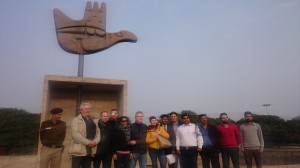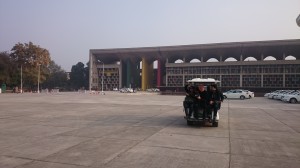Mission of European delegates to India (18-22 January 2016) and conference in Mumbai (23 January 2016). Press coverage here.
The programme of the visit to India was designed for European representatives of local and regional authorities that were accompanied by representatives of relevant business sectors. The event consisted of working visits in Chandigarh, Pune, Mumbai and Navi Mumbai.
European experts delivered lectures based on their practical experiences on sustainable urban and regional development. They also visited relevant projects in order to strengthen their cooperation within the World Cities project and develop an agenda for future collaboration.
Cities involved and programme design
Representatives from the European cities of Rome (Region of Lazio), Stuttgart, Copenhagen and Málaga/Sevilla (Andalucía Samrt City Cluster) debated with colleagues from Mumbai, Navi Mumbai, Pune and Chandigarh about their cooperation projects in the area of smart and green development as well as on innovation and the promotion of mutual economic exchange.
The programme started with a three-day visit to Chandigarh for all European delegates from the 4 pairing cities or city regions (Stuttgart, Copenhagen, Lazio and Andalucía). The pairing city of Chandigarh within the World Cities programme is Copenhagen, but EU representatives from Lazio and Stuttgart were also able to exchange views on their perspectives to the pilot areas of cooperation.
The visit to Chandigarh included field visits to following areas:
1. Sewage treatment. Chandigarh city has a well-planned underground network of pipes for the disposal of sewerage generated in the city. The sewerage system of the city has been designed by taking into account the natural slope of the city, which is from north to south. Chandigarh is fully covered with sewerage facility. Out of 87 MGD water being supplied to the residents of the city, 57 MGD sewage effluent is being generated. It is on the way of becoming the only city in India with 100% sewage treatment in the near future.
2. Energy Efficiency. Chandigarh Solar City. A “solar city” is an urban area that aims to: a) reduce dependence on fossil fuels for its energy needs, and b) limit emission levels to sustainable levels even while maintaining the desired socio-economic development growth. Delegates were able to visit a solar photovoltaic power generation facility in the roof top at Chandigarh University.
3. Mobility and Smart City: The visit will include the Capital Complex (applying for UNESCO world heritage status) and many projects in that area. Chandigarh Administration has promoted the use of battery operated vehicles by providing subsidies. A multilevel parking at the centre of the city has been at the verge of completion to promote vehicular free zones and control over vehicular density on the roads. Chandigarh is strictly following the smoke free city concept and practicing on the spot challans for the offenders. A concept of Metro transport has been approved for the city to promote public transport and control the vehicular air emissions. The construction of new and connecting the available inter-sector bicycle tracks is proposed to promote emission free, and healthy environment.
After the field visits, delegates attended a workshop headed by Mr Vikram Dev Dutt, Secretary for Transport and Environment at UT Chandigarh. The meeting also involved high level experts, including the Commissioner of Chandigarh’s Municipal Corporation, Mr B Purushartha, as well as the Chief Engineer, the Chief Architect, the Chief Conservator Forests & Director Environment, the Project Director for Intelligent Transportation Systems and the Director for Solar City developments. Delegates discussed about urban development (smart city, non-motorised transportation), environmental technologies (sewage and waste treatment) and climate change (mitigation, adaptation, energy saving).
The visit to Chandigarh was widely covered by the press.
After meetings in Chandigarh, delegates travelled to will travel to Mumbai, the capital city of the Indian state of Maharashtra. Mumbai is the most populous city in India and the eighth most populous city in the world, with an estimated city population of 18.4 million. The pairing city for Mumbai within the World Cities project is Stuttgart, one of the key engines of European economic and green development.
Delegates from Lazio also visited their pairing city of Navi Mumbai, developed in 1972 as a new urban township of Mumbai. The population of Navi Mumbai has reached more than 1 million inhabitants. It is one of the world’s largest planned new cities that was conceived as a satellite city to relief the strain on Mumbai. The City and Industrial Planning Corporation of Maharashtra (CIDCO) is responsible for both its planning and implementation. To minimise travel distances the city is developed on nodal patterns, similar to the suburbs of Mumbai.
Delegates from Andalucía Smart City Cluster visited Pune, having meetings with Pune Municipal Corporation as well as with companies involved in smart city development activities.
The programme ended end with a conference of the World Cities project that took place in cooperation with the Stuttgart-Meets-Mumbai event.
If you want to see the programme and the participants list, please click here:
Programme EU in India_Jan 2016_20160115_rev
Results (see also Pilot Projects)
1) Chandigarh (cooperation mainly with Copenhagen / CLEAN Cluster)
- Sewage treatment: Upgradation of Sewage Treatment Plants (STPs)and conception of Effluent Treatment Plants (ETPs): Experts from Copenhagen and Stuttgart presented technical solutions for the upcoming programmes to be launched by the Chandigarh Municipal Commission CMP. The Municipal Commissioner will travel in February to Copenhagen to further discuss concrete tendering procedures. Main business partner from the EU side is Rambøll (DK) and the Sewage Treatment Plant of Stuttgart.Waste Management and Energy Efficiency. After the visit to Chandigarh, European and Indian experts agreed to further cooperate in the areas of waste management. Here the Regional Government of Lazio offered a bilateral cooperation between the municipal corporation AMA – the biggest Italian operator in environmental services and integrated waste management. and the CMP. Regarding energy efficiency, the Italian Energy Efficiency Agency ENEA offered support regarding smart street lighting. Danfoss is keen to provide support to Chandigarh regarding district heating and district cooling solutions.
- Urban Development – non motorized transportation: Development of pedestrian and cycling areas as pilot projects in sector 35 and/or 17. The international urban developer GEHL Architects (DK) had made a business proposal to the Chandigarh administration (CMP and to the UT Administrator). During the site visit all relevant stakeholders were involved and are very interested in rapid implementation. The Chandigarh authority is currently discussing the tendering procedure in order to offer a transparent and open approach. Cooperation with Stuttgart is intended within UNESCO’s heritage programme to Le Corbusier buildings (Stuttgart has also some).
- Bilateral MoU with Copenhagen: The Advisor and the Secretary have agreed that there should be a document signed between both cities in order to cement the relationship. This would facilitate the rapid financial support to bilateral pilot projects. It was intended to sign a MoU with the CLEAN Cluster, which had been empowered by Copenhagen City Council to do so. However, Chandigarh officials insisted on signing an MoU with City Authorities. We are currently evaluating how to make this happen within the next few weeks.
2) Mumbai (cooperation mainly with Stuttgart)
- Urban Development: Cooperation between MMRDA and Stuttgart Urban Development Unit regarding sustainable development brownfield areas and regional information systems.
- Support to MMRDA’s Environmental Database. The head of Stuttgart Environmental Department, Dr Hans-Wolf Zirkwitz, provided technical support regarding the indicators of such a base to be developed by MMRDA. Stuttgart will also facilitate best practices regarding the role of public awareness measures to communicate to citizens the positive results of green city development.
- Climate change. Stuttgart is preparing the launch of a bilateral climate partnership with Mumbai covering areas like mitigation and adaptation strategies (climate atlas), energy efficiency (lower consumption) and access to energy. Talks were held between Stuttgart (Mayor, Heads of relevant departments) with the Commissioners of MCGM and MMRDA.
3) Navi Mumbai (cooperation mainly with Lazio)
- Cooperation with Lazio on the Review of NAINA Regional Development Plan. Lazio has been shortlisted to prepare an offer. Tendering process ongoing.
- Cooperation on smart-city development. Similar to Chandigarh, the Italian Energy Efficiency Agency ENEA offered support regarding smart street lighting. ENEA also identified support measures in the sustainable mobility area including smart transport services (buses on demand). Cooperation also includes the protection of critical infrastructures and building smart districts ICT platforms.
- Waste Management. Here the Regional Government of Lazio offered a bilateral cooperation between the municipal corporation AMA – the biggest Italian operator in environmental services and integrated waste management. and CIDCO.
4) Pune (cooperation mainly with Andalucía). Delegates from Andalucía Smart City Cluster had a very first contact with Pune Municipal Corporation. During the three-day visit they identified cooperation projects in three different smart city areas:
- Cooperation on smart mobility – e-cars fleet
- Cooperation on developing a Technology Park
- Cooperation on developing an ICT platform for smart city services












